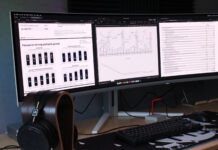A while back, TechPowerUp posted an article which investigated a discrepancy that had surfaced during the testing of the card. Somehow the card and drivers used a 25MHz crystal, but the card doesn’t have a physical 25MHz crystal, only 27MHz. When they dug deeper they found an interesting link between the performance and the PCIe frequency. They scaled linearly, but for some reason it wasn’t reported to the user through higher GPU frequency. A “secret” boost.
Expreview decided to make a follow-up where they tested how the performance scaled with PCIe frequency and if adjusting the GPU frequency scales in the same way. Their results are quite interesting and adds to the mystery.
Adjusting the PCIe frequency will result in a linear scaling of the multi-texture performance in 3DMark 06. Adjusting the GPU frequency in a corresponding way, the performance will not scale linearly. Instead for every 3% increase, the card gets a boost. Just like a normal NVIDIA card would react.
This leaves us wondering exactly what the PCIe frequency does, because it doesn’t have this kind of effect with any other card, just GeForce 9600GT. Clearly, adjusting the GPU frequency does not have the same effect as the PCIe frequency, but when overclocking the right way, it behaves just like any other card.
NVIDIA’s official statement is that the card has a 25MHz crystal, which just isn’t found anywhere on the PCB. The PCIe frequency divided by 4 gets you the crystal, but there are still things missing here.


















